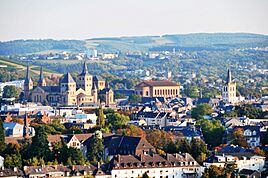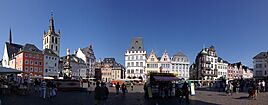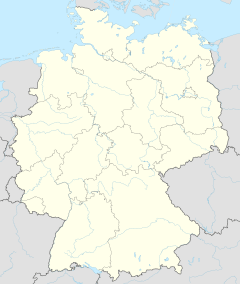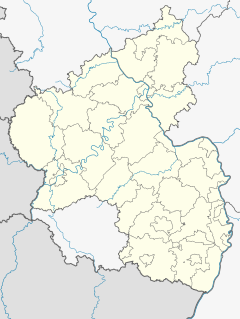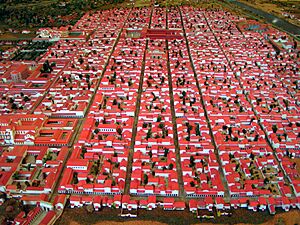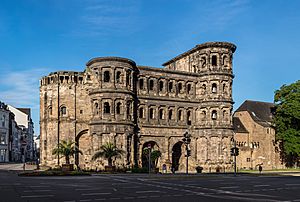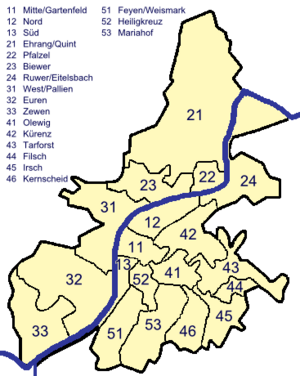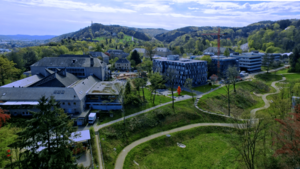Trier facts for kids
Quick facts for kids
Trier
Tréier (Luxembourgish)
|
|||
|---|---|---|---|
|
Trier skyline
Porta Nigra
Aula Palatina
Trier Cathedral and Liebfrauenkirche
Trier market place
|
|||
|
|||
| Country | Germany | ||
| State | Rhineland-Palatinate | ||
| District | Urban district | ||
| Founded | 17 BC | ||
| Area | |||
| • Total | 117.06 km2 (45.20 sq mi) | ||
| Elevation | 137 m (449 ft) | ||
| Population
(2022-12-31)
|
|||
| • Total | 112,195 | ||
| • Density | 958.44/km2 (2,482.35/sq mi) | ||
| Demonym(s) | Trevian | ||
| Time zone | UTC+01:00 (CET) | ||
| • Summer (DST) | UTC+02:00 (CEST) | ||
| Postal codes |
54290–54296 (except 54291)
|
||
| Dialling codes | 0651 | ||
| Vehicle registration | TR | ||
| Website | www.trier.de | ||
Trier is a historic city in Germany, located on the banks of the Moselle River. It sits in a valley surrounded by hills covered in vineyards, close to the border with Luxembourg. This area is famous for its wine.
The Romans founded Trier in the late 1st century BC, calling it Augusta Treverorum. Many people consider Trier to be Germany's oldest city. It is also the oldest place north of the Alps where a bishop has had his main church, called a cathedral. Trier was even one of the four main cities of the Roman Empire for a while.
Later, in the Middle Ages, the powerful archbishop-elector of Trier was an important church leader. He also helped choose the emperor of the Holy Roman Empire. Because of its long and important history, many of Trier's ancient buildings and churches are now protected as a UNESCO World Heritage Site.
Today, Trier has about 110,000 people, making it the fourth-largest city in its state, Rhineland-Palatinate. It's a central place for education and business, home to the University of Trier and the Academy of European Law. Trier is also part of the QuattroPole group of cities, working together with Luxembourg City, Metz, and Saarbrücken.
Contents
A Journey Through Trier's History
Trier has a very long history, with traces of early human settlements from thousands of years ago. Before the Romans arrived, a Celtic tribe called the Treveri lived here. The city's name, Trier, comes from the Roman name for the area.
The Roman Empire took control of the Treveri people in the 1st century BC. Around 16 BC, they founded the city of Augusta Treverorum. This city became the capital of a large Roman province called Belgic Gaul. For a long time, from 293 to 395 AD, Trier was one of the homes for the Western Roman Emperor. In the 4th century, it was one of the biggest cities in the Roman Empire, with up to 100,000 people. The famous Porta Nigra (meaning "Black Gate") was built during this time.
Around 407 AD, the Roman government moved its main offices from Trier to another city. However, Trier remained an important place. It still had factories that made weapons and uniforms for Roman soldiers.
From Franks to the Holy Roman Empire
The Franks took over Trier from the Romans in 459 AD. Later, in 870, it became part of a kingdom that grew into the Holy Roman Empire. The city became a popular place for pilgrimages because of the relics of Saint Matthias brought there. The bishops of Trier became very powerful. Their land was known as the Archbishopric of Trier, and they were one of the most important electors (people who chose the emperor) in Germany. The University of Trier was first started in 1473.
Wars and Changes
In the 17th and 18th centuries, Trier saw many wars between France and the Habsburg family. French troops often occupied the city. After the French Revolutionary Wars, France took control of Trier. But after the Napoleonic Wars ended in 1815, Trier became part of the Kingdom of Prussia.
Karl Marx, a famous German philosopher, was born in Trier in 1818. The city grew economically during the 19th century as part of the Prussian Rhineland.
Trier in Modern Times
During World War II, Trier was heavily bombed in 1944. After the war, it became part of the new state of Rhineland-Palatinate. The University of Trier, which had closed in 1797, was reopened in the 1970s. The Cathedral of Trier also reopened in 1974 after major repairs. In 1984, Trier celebrated its 2,000th anniversary.
More recently, in December 2020, a tragic incident occurred when a driver caused fatalities in the city. In July 2021, the Ehrang/Quint district of Trier was badly damaged by floods.
Trier's Location and Surroundings
Trier is nestled in a valley along the Moselle River. Most of the city is on the east side of the river. The surrounding hills are covered with forests and vineyards. To the south, you'll find the Hunsrück plateau, and to the north, the Eifel region. The border with Luxembourg is only about 15 kilometers away.
How Trier is Organized
The city of Trier is divided into 19 different districts. Each district has its own local council and a local representative. These councils discuss important issues for their district. However, the city council makes the final decisions.
Trier's Weather
Trier has a mild climate, meaning it doesn't usually get extremely hot or cold. Summers are generally warm, and winters are cold but not usually harsh. It rains quite a bit throughout the year. The highest temperature ever recorded in Trier was 40.6 °C in July 2019. The lowest was -19.3 °C in February 1956.
Amazing Sights in Trier
| UNESCO World Heritage Site | |
|---|---|
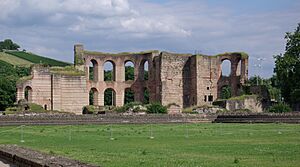
Ruins of the Imperial Baths
|
|
| Includes | Amphitheater, Roman bridge, Barbara Baths, Igel Column, Porta Nigra, Imperial Baths, Aula Palatina, Cathedral and Liebfrauenkirche |
| Criteria | Cultural: i, iii, iv, vi |
| Inscription | 1986 (10th Session) |
Trier is famous for its many well-preserved Roman and medieval buildings. These include:
- The Porta Nigra: This is the best-preserved Roman city gate north of the Alps. It's a huge, impressive structure.
- The Aula Palatina: Also known as the Constantine Basilica, this was a massive throne hall for the Roman emperor Constantine I. It's 67 meters long and is now used as a Protestant church. Next to it is the Electoral Palace, Trier.
- The Roman Trier Amphitheater: Here, Romans watched gladiator fights and other shows.
- The Roman bridge: Built in the 2nd century AD, this bridge crosses the Moselle River. It's the oldest bridge north of the Alps still used by traffic today!
- Roman bath ruins: You can see the remains of three large Roman baths, including the Barbara Baths and the Trier Imperial Baths.
- Trier Cathedral: This Catholic church dates back to Roman times. Its Romanesque front with four towers is very grand. The Cathedral holds the Holy Tunic, which some believe is the robe Jesus wore.
- The Liebfrauenkirche (Church of Our Lady): This is one of Germany's most important early Gothic churches.
- St Matthias' Abbey: This is a working monastery. Its medieval church is believed to hold the tomb of an apostle (Saint Matthias) north of the Alps.
- Saint Paulinus' Church: A beautiful Baroque church, partly designed by the famous architect Balthasar Neumann.
Museums to Explore
Trier has several museums where you can learn more about its past:
- The Rheinisches Landesmuseum: This important museum focuses on the Roman period, with many archaeological finds.
- The Treasury of Trier Cathedral: Here you can see valuable religious items, including relics and old manuscripts.
- The Museum am Dom: This museum displays religious art and some Roman artifacts.
- The Stadtmuseum Simeonstift: Learn about Trier's history, including a model of the medieval city.
- The Karl Marx House: This museum is in the house where Karl Marx was born. It shows his life, writings, and the history of socialism.
- The Toy Museum of Trier: A fun place to see old toys!
- The Roscheider Hof: Located nearby, this museum shows what rural life was like in the region.
Learning in Trier
Trier is a center for education. It is home to the University of Trier, which was first founded in 1473 and reopened in 1970. There is also the Trier University of Applied Sciences. The Academy of European Law (ERA) offers training in European law. The city has many schools, from kindergartens to secondary schools.
Fun Annual Events
Trier hosts several exciting events each year:
- The Altstadtfest: A city festival held in late June in the center of Trier.
- The Zurlaubener Heimatfest: Celebrated two weeks after the Altstadtfest, this festival takes place along the Moselle River.
- The German round of the World Rally Championship: Since 2002, Trier has been the base for this international car rally.
- The Trier Christmas Market: Every year, a festive Christmas market is held in the main market square and in front of the Cathedral.
- The Olewiger Weinfest: An annual wine festival in the village of Olewig, near Trier. It features wine tastings, live music, and food.
Getting Around Trier
Trier station offers direct train connections to cities like Cologne, Saarbrücken, and Luxembourg. Major highways connect Trier to other parts of Germany and Luxembourg. The nearest international airports are in Luxembourg, Frankfurt-Hahn, and Saarbrücken. The Moselle River is also used for shipping and river cruises.
Sports in Trier
Trier has several sports clubs:
- SV Eintracht Trier 05: For association football.
- Gladiators Trier: For basketball.
- DJK/MJC Trier: For women's team handball.
- Trier Cardinals: For baseball.
- PST Trier Stampers: For American Football.
Trier's Global Connections
Trier is part of the QuattroPole group of cities, working with Luxembourg City, Saarbrücken, and Metz.
Sister Cities
Trier has many sister cities around the world, helping to build friendships and understanding:
- Gloucester, England, UK (1957)
- Metz, France (1957)
- Ascoli Piceno, Italy (1958)
- ['s-Hertogenbosch]], Netherlands (1968)
- Pula, Croatia (1971)
- Weimar, Germany (1987)
- Fort Worth, United States (1987)
- Nagaoka, Japan (2006)
- Xiamen, China (2010)
- Izium, Ukraine (2024)
Places Named After Trier
Some places in the United States were named after Trier by people who moved there from the city:
- New Trier Township, Illinois
- New Trier, Minnesota
- New Trier High School, an Illinois school
Famous People from Trier
Many notable people have connections to Trier, including:
- Constantius Chlorus (c. 250–306), a Roman emperor.
- Maximian (c. 250–310), another Roman emperor.
- Helena (c. 250–330), a saint and mother of Emperor Constantine the Great.
- Ambrose (c. 340–397), a saint.
- Karl Marx (1818–1883), a famous social philosopher.
- Udo Samel (born 1953), an actor.
- Eric Jelen (born 1965), a tennis player.
Images for kids
See also
 In Spanish: Tréveris para niños
In Spanish: Tréveris para niños


